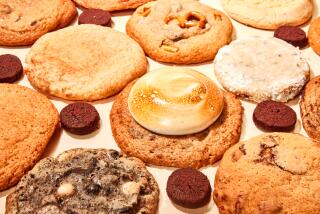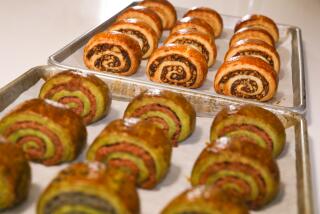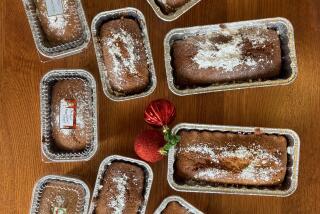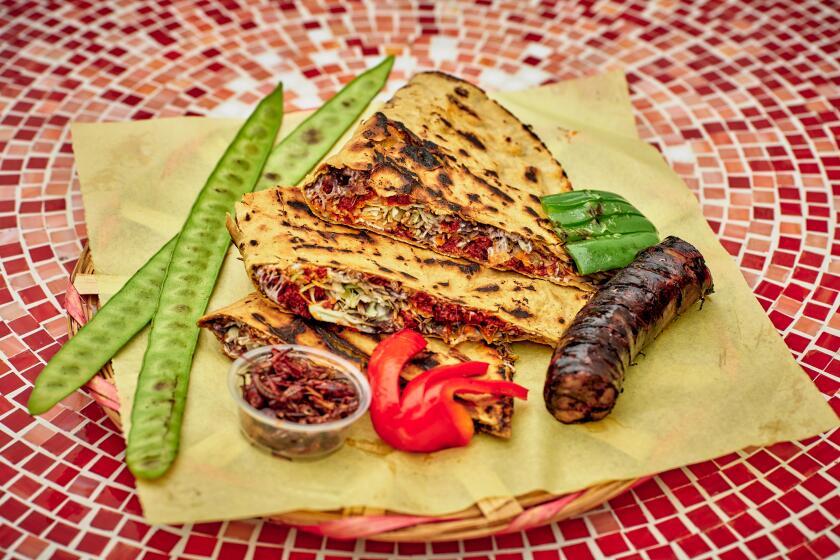‘The Art of French Pastry’: Going deep in pastry making
If you’re ready to plunge into the craft of making pastries, there are few books as thorough as “The Art of French Pastry” (Knopf, $40), by master pastry chef Jacquy Pfeiffer with local author Martha Rose Shulman. Pfeiffer, who grew up in Alsace learning to bake in his family’s boulangerie and eventually founded the French Pastry School in Chicago, was featured in the documentary “Kings of Pastry.”
In this book he presents a manual of classics such as croissants, eclairs, brioche, tarts, cookies and gateaux that is an in-depth, hand-holding guide for both fearful and fearless bakers.
Recipes are only the beginning of what the book provides. Instruction starts far before you turn on your oven, by telling you exactly what equipment to gather and which ingredients to bring to room temperature. There are also tips, tricks, takeaways, contingencies, charts and graphics -- such as one showing exactly how to cut plums for a tart or how to roll a Yule log.
The recipe for classic puff pastry is seven pages long. If you want to make a Napoleon or mille-feuille with that puff pastry, it’s an additional four pages. But that’s because the instructions are written so that it’s almost as if Pfeiffer were there next to you telling you exactly what to do each step of the way, and why.
He explains that all-purpose flour is used because of its lower gluten content, white vinegar to relax the gluten and French-style butter for its higher fat content. And he will show you how to make the detrempe, or dough base, by hand so that you know what it should feel like. But he also includes instructions for making it in a stand mixer.
Even caramelized nuts is a four-page recipe (when in some other books it might be half a page) because Pfeiffer includes an alternative method, an exposition on the Maillard reaction during nut roasting and on why coating nuts with cocoa butter is a good idea, a how-to on skinning nuts, and a full-page nut-roasting chart with roasting times for any imaginable nut whether whole, chopped, sliced or slivered, with or without their skins.
There are some briefer recipes, especially in the cookies chapter. It might be a good time to try making sablés de Noël (see recipe below).
Interspersed throughout the book are anecdotes about growing up in a bakery family (such as making hundreds of Yule logs during the holidays) and his experiences and lessons learned as an apprentice (don’t stir caramel so quickly that it splatters on you). He was even a pastry chef in the French navy, on an oil tanker. “Only the French navy sees the necessity of having a pastry chef on board a naval vessel in times of war,” he wrote.
Christmas sablés / sablés de Noël
For the egg wash
50 grams (1 extra large) egg
5 grams (1 teaspoon) heavy cream or whole milk
0.4 gram (small pinch) sea salt
Before you begin
Get out the following equipment and allow all of the ingredients to come to room temperature:
Digital scale, set to metric weights
1 small bowl
1 stainless steel hand whisk
1 fine strainer
In a small bowl, whisk together the egg, cream or milk, and sea salt. Pass through a fine strainer into a small bowl or jar, cover and store in the refrigerator for up to 2 days.
For the sables
300 grams (2-1/3 cups) flour
100 grams (1 cup) almond flour
2 grams (1 teaspoon) ground cinnamon
200 grams (7 ounces) butter (French style, 82% fat)
10 grams (2 teaspoons) vanilla extract or paste
150 grams (3/4 cup plus 2 teaspoons) granulated sugar
3 grams (3/8 teaspoon) sea salt
40 grams (1 extra large egg less 4 teaspoons) whole egg
Egg wash
Before you begin
Get out the following equipment and allow all of the ingredients to come to room temperature:
Digital scale, set to metric weights
1 sifter
1 medium mixing bowl
Stand mixer fitted with the paddle attachment
1 rubber spatula
1 bowl scraper
Plastic wrap
1 sheet pan lined with parchment paper
1 rolling pin
Assorted cookie cutters
1 pastry brush
Note: The butter should be soft.
Read this recipe through twice from start to finish.
Ingredients
300 grams (2-1/3 cups) all-purpose flour
100 grams (1 cup) almond flour
2 grams (1 teaspoon) ground cinnamon
200 grams (7 ounces) butter (French style, 82% fat)
10 grams (2 teaspoons) vanilla extract or paste
150 grams (3/4 cup plus 2 teaspoons) granulated sugar
3 grams (3/8 teaspoon) sea salt
40 grams (1 extra large egg less 4 teaspoons) whole egg
Egg wash
Sables de Noel, one of the traditional cookies we call bredele de Noel, are usually shaped like Christmas trees, stars or snowmen, which are all symbolic of the December holidays. These simple, luscious cookies, made from a rich butter dough flavored with vanilla, ground cinnamon and almonds, can be addictive.
1. Sift the flour and the almond flour and combine them in a bowl. Add the cinnamon.
2. Place the butter, vanilla, sugar and sea salt in the bowl of your mixer and mix with the paddle for 2 minutes on medium speed. Add the egg and mix for another 2 minutes. Scrape the bottom of the mixing bowl with a rubber spatula to make sure that all the ingredients are mixed together.
3. Add the dry ingredients and mix until they just come together. Stop the machine and scrape the bottom and sides of the bowl and the paddle, then beat again just until the dough is amalgamated. Do not over-beat or you will activate the gluten in the flour and the dough will be rubbery. Scrape the dough out of the mixer onto a sheet of plastic wrap. Divide into 2 equal pieces and press each piece gently until it is about 1/2 to 3/4 inch thick. Wrap airtight and refrigerate for at least 2 hours and preferably overnight to allow the flour to absorb the water in the dough. This will make the dough much more stable and easier to roll out.
4. When you are ready to roll out the dough and shape and bake the cookies, heat the oven to 325 degrees with the rack positioned in the middle. Line the sheet pans with parchment paper. Lightly dust your work surface or a silpat with flour. It may be easiest to cut each piece of dough in half and roll out 1 small piece at a time. Take the piece you are going to roll out from the refrigerator and let sit at room temperature for 5 minutes. Then roll out to 3/16 of an inch, cut into shapes with the cookie cutters of your choice and place on the sheet pans. Do not cut on the silpat.
5. Brush the tops of the cookies lightly with egg wash, taking care not to allow it to drip down the sides of the cookies. Let sit for 10 minutes and apply a second thin layer of egg wash.
6. Bake for 15 to 20 minutes, reversing the pan front to back halfway through until they are golden brown throughout. The low oven temperature will allow all of the water to evaporate, resulting in a very flaky cookie.
It’s done when it’s done
The finished product should be golden brown throughout. This means that you have baked it long enough.
Storage
The cookies will keep for 1 month in a tin or an airtight container.
Jacquy’s takeaways
The dough can be refrigerated for 3 to 5 days or can be frozen. The finished product should not be frozen.
If you want to hang some of these on your Christmas tree, use the end of a chopstick to make a hole in the cookies before you bake them. After the cookies are baked and cooled, thread the holes with ribbon and hang on your tree.
ALSO:
Easy dinner: 3 warm and comforting lentil recipes
‘Tartine Book No. 3’ is a modern trip through ancient grains
More to Read
Eat your way across L.A.
Get our weekly Tasting Notes newsletter for reviews, news and more.
You may occasionally receive promotional content from the Los Angeles Times.









